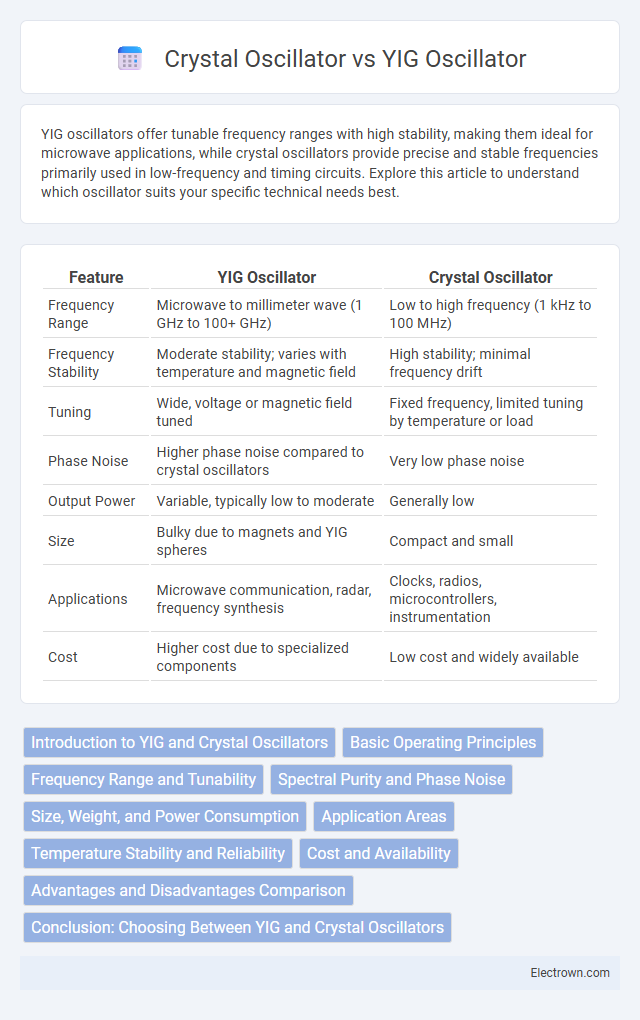YIG oscillators offer tunable frequency ranges with high stability, making them ideal for microwave applications, while crystal oscillators provide precise and stable frequencies primarily used in low-frequency and timing circuits. Explore this article to understand which oscillator suits your specific technical needs best.
Table of Comparison
| Feature | YIG Oscillator | Crystal Oscillator |
|---|---|---|
| Frequency Range | Microwave to millimeter wave (1 GHz to 100+ GHz) | Low to high frequency (1 kHz to 100 MHz) |
| Frequency Stability | Moderate stability; varies with temperature and magnetic field | High stability; minimal frequency drift |
| Tuning | Wide, voltage or magnetic field tuned | Fixed frequency, limited tuning by temperature or load |
| Phase Noise | Higher phase noise compared to crystal oscillators | Very low phase noise |
| Output Power | Variable, typically low to moderate | Generally low |
| Size | Bulky due to magnets and YIG spheres | Compact and small |
| Applications | Microwave communication, radar, frequency synthesis | Clocks, radios, microcontrollers, instrumentation |
| Cost | Higher cost due to specialized components | Low cost and widely available |
Introduction to YIG and Crystal Oscillators
Yttrium Iron Garnet (YIG) oscillators utilize a magnetic resonance effect in ferrite materials to achieve highly tunable microwave frequencies, making them essential for radar and communication systems. Crystal oscillators rely on the piezoelectric property of quartz crystals to maintain a stable and precise frequency, commonly used in clocks, radios, and microcontrollers. Your choice between YIG and crystal oscillators depends on the need for wide frequency tunability versus frequency stability.
Basic Operating Principles
YIG oscillators operate based on the magnetostatic spin wave resonance in yttrium iron garnet spheres, where an external magnetic field adjusts the oscillation frequency, enabling wide tunability in microwave applications. Crystal oscillators rely on the piezoelectric effect in quartz crystals, producing stable and precise frequencies through mechanical vibrations at their natural resonant frequency. The fundamental difference lies in YIG oscillators' magnetic tuning mechanism versus the rigid mechanical resonance of crystal oscillators, affecting their applications in frequency agility and stability.
Frequency Range and Tunability
YIG oscillators offer a broad frequency range typically from 500 MHz to 40 GHz, making them highly tunable for microwave and RF applications. Crystal oscillators operate within narrower frequency bands, generally up to 200 MHz, but provide exceptional frequency stability and low phase noise. The tunability of YIG oscillators is achieved through magnetic field adjustments, whereas crystal oscillators rely on fixed resonant frequencies determined by their quartz crystal cut.
Spectral Purity and Phase Noise
YIG oscillators exhibit superior spectral purity and ultra-low phase noise characteristics compared to crystal oscillators, making them ideal for high-frequency and microwave applications requiring clean signal generation. Crystal oscillators offer excellent frequency stability and low phase noise at lower frequencies but typically cannot match the spectral purity achievable with YIG technology at microwave ranges. Understanding the demands of your application is essential to selecting between YIG oscillators for enhanced spectral performance or crystal oscillators for stable, low-noise signals at lower frequencies.
Size, Weight, and Power Consumption
YIG oscillators generally have larger size and higher weight compared to compact and lightweight crystal oscillators due to their magnetic components. YIG oscillators consume more power, often several watts, while crystal oscillators operate efficiently at milliwatt power levels. These differences make crystal oscillators preferred for low-power, miniaturized applications, whereas YIG oscillators suit high-frequency, tunable requirements despite increased size and power demands.
Application Areas
YIG oscillators are widely used in microwave frequency synthesis, radar systems, and communication test equipment due to their tunability and low phase noise at high frequencies. Crystal oscillators dominate in applications requiring high frequency stability and precision, such as timekeeping in clocks, microprocessors, and telecommunications equipment. Your choice between these oscillators depends on whether tunability or frequency stability is more critical for your specific application.
Temperature Stability and Reliability
YIG oscillators offer exceptional frequency tunability with moderate temperature stability, making them suitable for applications requiring wide frequency ranges. Crystal oscillators provide superior temperature stability and long-term reliability due to their precise quartz resonator, ensuring minimal frequency drift in varying environmental conditions. For critical applications demanding consistent performance, your choice should favor crystal oscillators when temperature stability and reliability are paramount.
Cost and Availability
YIG oscillators typically have higher costs due to their complex construction and are less readily available compared to crystal oscillators, which benefit from mass production and widespread use in consumer electronics. Crystal oscillators are cost-effective and widely accessible, making them suitable for most standard frequency control applications. Your choice depends on budget constraints and the need for precision, where crystal oscillators offer a more economical solution.
Advantages and Disadvantages Comparison
YIG oscillators offer wide tunability and low phase noise, making them ideal for microwave frequency synthesis and radar applications, but they tend to be larger, more complex, and less stable over time compared to crystal oscillators. Crystal oscillators provide excellent frequency stability, low cost, and compact size, suitable for precise timing in communication devices, though they lack the frequency agility and high-frequency range of YIG oscillators. Your choice depends on whether frequency precision or tunability is the priority in the intended application.
Conclusion: Choosing Between YIG and Crystal Oscillators
Choosing between YIG oscillators and crystal oscillators depends on application requirements such as frequency range, stability, and tunability. YIG oscillators excel in wide frequency tuning and high-frequency microwave applications but have relatively lower frequency stability compared to crystal oscillators. Crystal oscillators offer superior frequency accuracy and low phase noise, making them ideal for precision timing and low-frequency applications.
YIG Oscillator vs Crystal Oscillator Infographic

 electrown.com
electrown.com